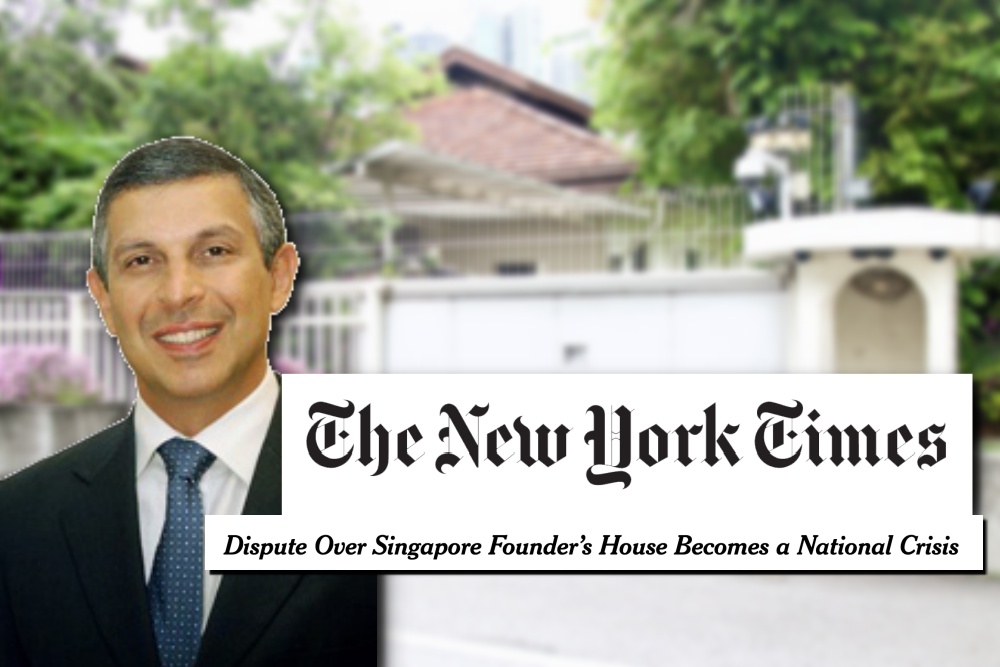The New York Times, the traditional beacon of hope for all things good journalism, seems to have dropped the ball in a recent piece about Singapore.
Ashok Mirpuri, Singapore's ambassador to the United States, criticised an NYT article ("Dispute Over Singapore Founder’s House Becomes a National Crisis”) dated July 4 about the dispute over the late Lee Kuan Yew's Oxley Road house, remarking snidely that he was "surprised" that "NYT did not seek any comments from Prime Minister Lee Hsien Loong or the Singapore government before writing the piece".
Not seeking both sides of the story; not seeking a response from the Singapore government, but yet publish a story that isn't a commentary carrying assertions about the Singapore government? So brave.
In his letter, which was released to media, Ashok added that the article "promotes the absurd notion that Singaporeans link the legitimacy of their government with the fate of Mr Lee Kuan Yew’s house".
The NYT article, written by Richard Paddock, a Pulitzer Prize-winning correspondent based in Bangkok, noted that the Lee "family dispute over the fate of (LKY's) modest house has shattered Singapore’s image as an orderly authoritarian ideal and hinted at deeper divisions about its political future".
The article also argued that the dispute between Prime Minister Lee Hsien Loong and his siblings Lee Hsien Yang and Lee Wei Ling has transformed the "estate battle into a national crisis" that has raised questions about how Singapore is governed, the legitimacy of the People's Action Party (PAP), and how the leaders are selected.
Putting aside the validity of these points Paddock made, one notes that it is common practice for journalists to write to governments to request responses from them — especially when the points made in the piece do appear to be his opinions, which aren't clearly substantiated by fact.
It's also normal, occasionally, to not receive a reply, which Paddock would have been able to acknowledge in his story by noting that the Singapore government declined a request for a response, or something to that effect.
Now, while appearing to have failed to approach the government for a response to these assertions, Paddock did speak to a 19-year student named "Tan Chuan Jin", as well as Sinapan Samydorai, a director at nonprofit Think Center, and former Nominated Member of Parliament and SMU law don Eugene Tan.
But yeah, include token response from the gahmen also can right?
Below is Ashok's full reply, since the NYT editors omitted the point Ashok made (italicised below) about them not approaching the Singapore government:
1. Your article “Dispute Over Singapore Founder’s House Becomes a National Crisis” [Jul 4] promotes the absurd notion that Singaporeans link the legitimacy of their government with the fate of Mr Lee Kuan Yew’s house. I am surprised that NYT did not seek any comments from Prime Minister Lee Hsien Loong or the Singapore government before writing the piece.
2. In response to accusations by his siblings of abuse of power over the house, Prime Minister Lee made a full statement in Parliament. He explained how he had recused himself from all government decisions concerning the house, and also sold the house to his brother, so that he no longer has any interest or influence over the house.
3. No Member of Parliament made any allegations of impropriety or wrongdoing against the PM during the debate, nor has anyone else produced specific evidence to back the siblings’ vague allegations. There is no national crisis in Singapore.
Top photo adapted via Ministry of Foreign Affairs website, file photo by Tan Guan Zhen and The New York Times.
If you like what you read, follow us on Facebook, Instagram, Twitter and Telegram to get the latest updates.
